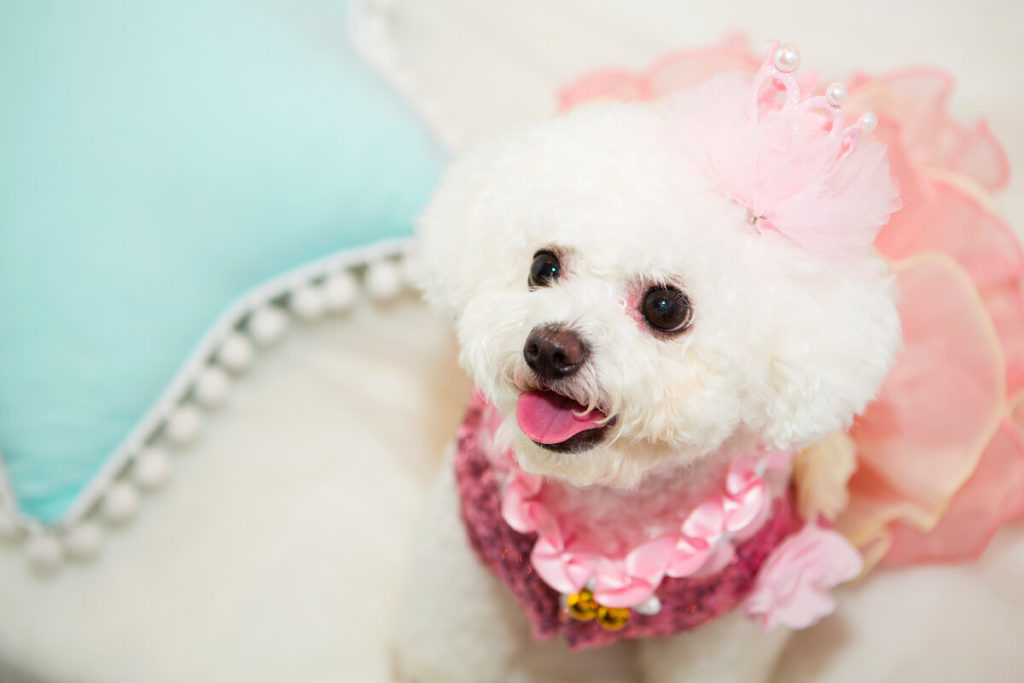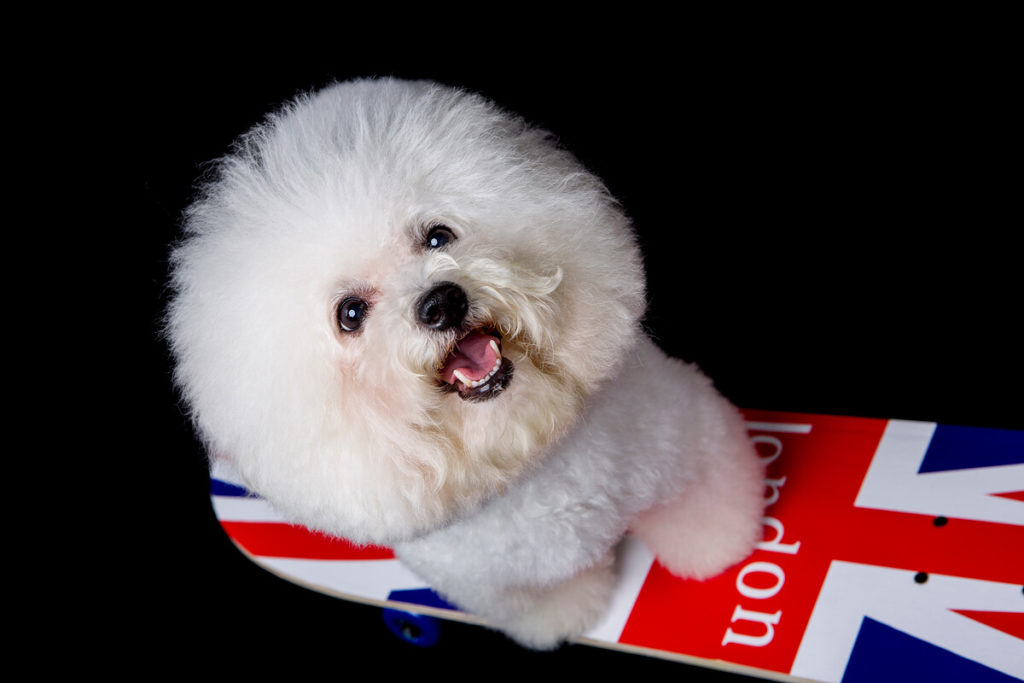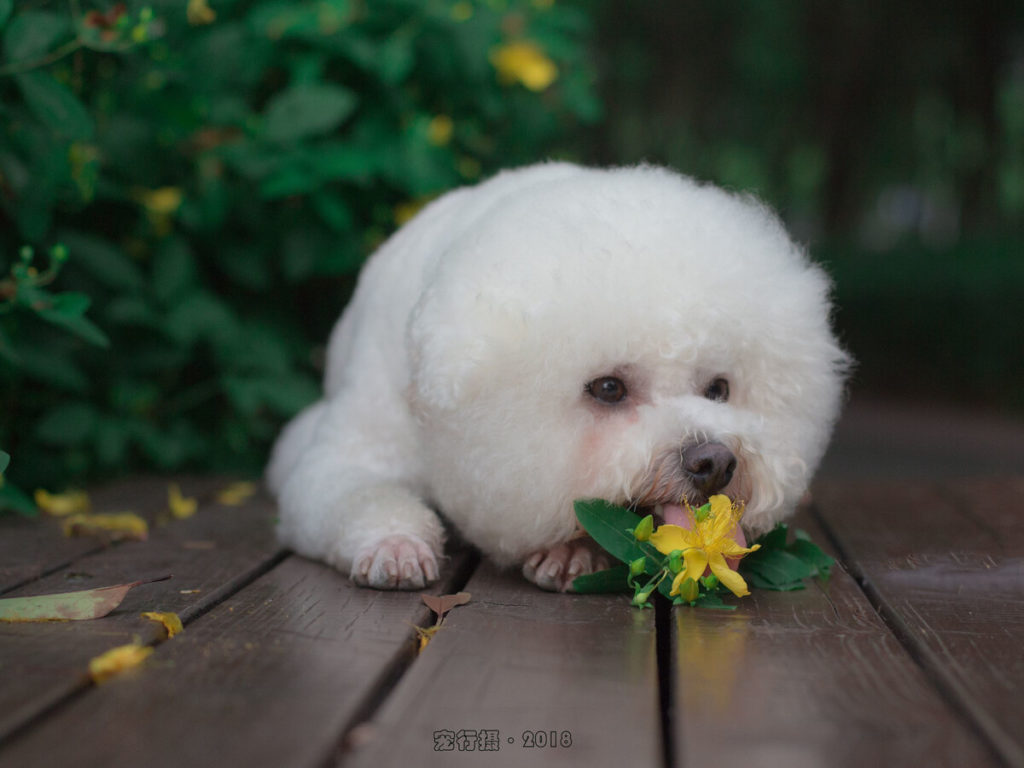If you don’t already understand Bichon Frise fur types, this information will explain why certain methods and tools are necessary when brushing Bichon Frise dog’s coat.
Having a good understanding of Bichon Frise fur stages will assist with Bichon Frise brushing techniques.
When they’re young, a Bichon Frise pup’s fur usually lacks substantial guard hairs and is virtually a single coat. This Bichon Frise fur is very soft and, although it grows, it won’t get too long because inside his first year, it all falls out. Hairs won’t shed much and they’re usually not long enough to get tangled.

Bichon Frise Coat Stages
Older Bichon Frise puppies, from around 4 – 6 months of age, move into the “Bichon Frise puppy uglies” phase (so named because the fur often looks quite patchy), where their puppy fur will fall out and be replaced by a new adult coat.
By the 12-15-month point, Bichon Frise are regarded to be adults and have a grown a huge double coat. Bichon Frise undercoat is short, soft, fluffy fur that’s tightly packed on his body. The outer layer is made of guard hairs that are noticeably longer. The whole coat is dense and a significant amount of shedding takes place (although you might not notice it) and there will be a lot of tangles which need to be brushed regularly to avoid problems.

How to Brush a Bichon Frise Puppy
The secret to training your Bichon Frise to enjoy brushing and all types of grooming procedures is to start early on Bichon Frise puppy grooming.
Train your Bichon Frise to lay quietly on each side, as well as on his back
for brushing and toenail trimming. Helping the puppy to understand he should be comfortable on his back is a very important part of training for grooming. If your Bichon Frise is uncomfortable in these positions, a simple alternative is to brush your Bichon Frise on your lap.
The Bichon Frise shouldn’t be allowed to get up if he’s struggling to get away.
Once he’s fully relaxed and soothed by the owner’s voice, then he can be allowed to get back on his feet and be rewarded with a treat. Quite often a puppy will prefer to remain on his back once he understands there’s no danger and will enjoy the extra attention.
Bichon Frise dogs coats require regular attention. Make grooming part of a routine with your dog, and you’ll both come to enjoy this special bonding time.
How Often Should You Brush a Bichon Frise?
Ideally, you would brush your Bichon Frise each day, either as a form of relaxation or while watching TV. However, most people’s lives aren’t always ideal. You can still get great results if you brush your dog every second day.
This will provide all the benefits mentioned previously. It’s critical to use the right sprays, brushes and combs. When in doubt, your breeder or groomer should be your first source of information. You can’t “over-brush” him so you can even do it every day. Bichon Frise brushing and/or combing prior to baths is essential so you can separate any tangles and separate them prior to using shampoo.
Bichon Frise puppies need to get brushed 2 – 3 times per week. This helps improve blood flow, distributes body oil, stimulates hair follicles, lets puppies get used to being brushed which is a bonus for both of you, especially when he becomes an adult and he will need to be brushed with greater intensity.
Every dog sheds hair and it must go somewhere. It may become entangled in the outer coat and cause a clump of matted hair. It may blow down your hall. It can get onto furniture, bedding, clothes or even you. When you brush your dog, it catches a lot of the shed hair. For that reason it is wise to groom every day, if possible.

How to Brush a Bichon Frise
The coat of a Bichon Frise dog is two layers. He has a dense undercoat that’s woolly and holds the outer hairs off the body. Then there’s the outer coat which is coarse and long and is known as a guard coat.
It’s simple to brush the outer coat so your dog looks great. However, you must also brush the undercoat to prevent it from becoming matted.
How to Brush a Bichon Frise: A Step-by-Step Guide
I apply the following 3 steps prior to either bathing or trimming my Bichon Frise dog. Applying these steps helps to ensure there are no matts, snags, tangles and each and every hair is separated.
- Step 1 is completely brushing my Bichon Frise using the line brushing technique. Line Brushing is a basic technique used to brush most long coated dog breeds. Using a pin brush commence from the shoulders and separate the coat in a line down to the skin from shoulder to base of the tail. Brushing one layer at a time. Pay attention to the areas that matt, tangle and knot easily; behind the ears, under the front legs and the groin area.
- Step 2 is repeating the first step using a soft slicker brush.
- Step 3 is repeating step 1 using a metal comb to completely comb through the Bichon Frise’s coat. When the comb easily glides through the Bichon Frise’s coat, preparation is complete. The comb is the last Bichon Frise grooming tool to be used on the coat.
Line Brushing
Best results are obtained by using a brushing method called line brushing. Laying your Bichon Frise on his side, work in rows down each side of the body, then repeat on the chest area, rump area and underneath the Bichon Frise. Brushing each layer of hair from the skin outwards.

Bichon Frise Brushing Helps Maintain Coat Health in 7 Ways
- Assessing and preventing tangles and mats
These words are often used interchangeably. Tangles are knots that form in his hair. Mats are thicker knots of weaved hair that’s very close to his skin. These problems can occur and grow rapidly; they can be hard to remove unless you cut off some of his fur, and the process can cause your Bichon Frise pain when his hairs get pulled in and his skin is pinched. You need to create a regular routine whereby you brush his coat to stop these issues from happening and, while you brush, check for small mats and tangles.
- Body oil gets distributed
A dog’s natural body oil seeps out of his pores and can quickly build up. When you brush his coat, that helps to distribute the oil more evenly. It dissipates the smell that can exist when oil just sits there on his skin. It also gives his fur that healthy shine.
- Bichon Frise brushing removes hairs that have been shed
Bichon Frise shed their hair all the time but there are usually two main seasonal sheds and most of the loose hair falls out from his undercoat. If you don’t pull out dead hairs, they can stop the circulation of air, attract accumulated body oil (which will make him smell bad) and they’ll twist with live hairs and cause mats to grow.
- Improved health for skin and coat
When you brush your Bichon Frise’s skin, it’s like a massage and it improves the flow of blood and stimulates hair follicles which lead to better fur growth.
- Tiny debris gets removed
Brushing gets rid of microscopic debris and bits of food that get collected by his coat.
- Golden opportunity to use a leave-in protective spray
While brushing, it’s the perfect time to use a conditioning spritz. A good quality spray will ensure his coat is moisturized properly, adds extra shine, stops mats and split ends and repels contact irritants and allergens, and any urine “splash back.”
- A well-groomed, tidy Bichon Frise
Brushing helps your Bichon Frise look presentable all the time and helps him feel better about himself. A healthy dog is a happy dog.




